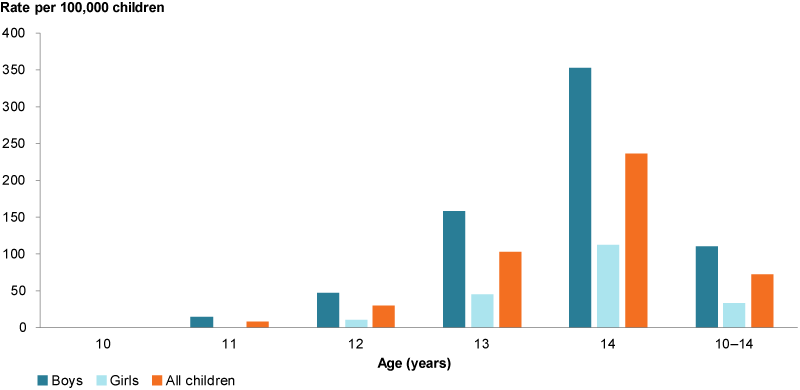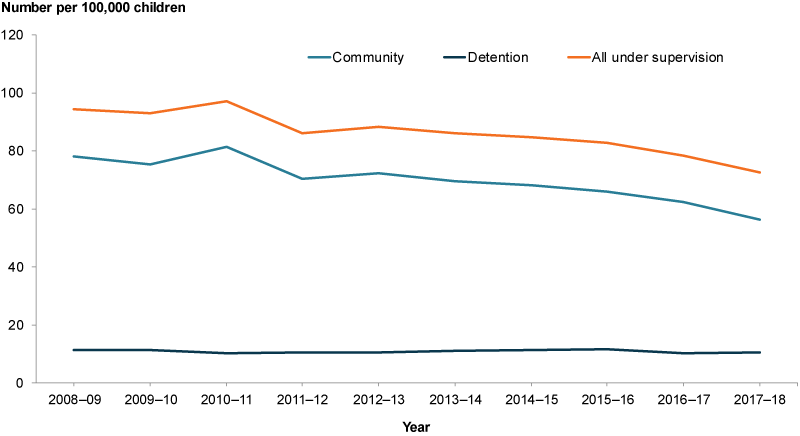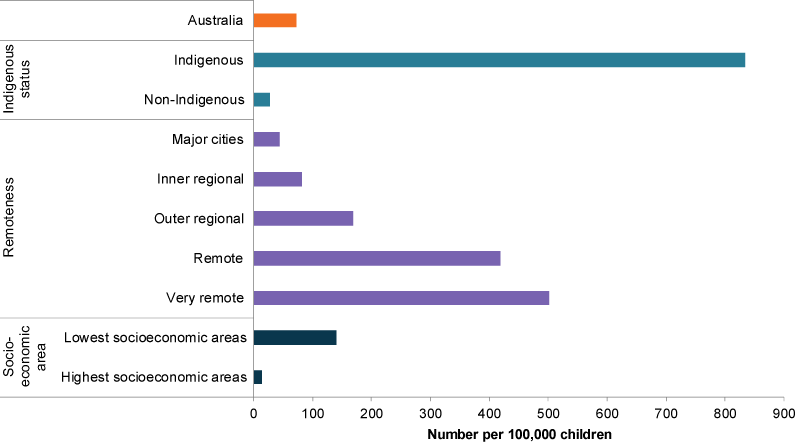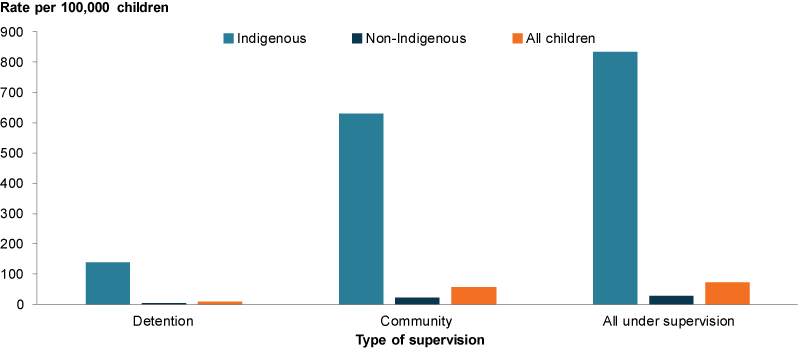Children under youth justice supervision
Data updates
25/02/22 – In the Data section, updated data related to children under youth justice supervision are presented in Data tables: Australia’s children 2022 – Justice and safety. The web report text was last updated in December 2019.
Key findings
- In 2017–18, around 1,100 children aged 10–14 were under youth justice supervision in Australia on an average day.
- Among children aged 10–14, boys were more than 3 times as likely under supervision as girls (110 per 100,000 compared with 33 per 100,000).
- The rates of children aged 10–14 under youth justice supervision and community-based supervision both decreased between 2008–09 and 2017–18 (95 per 100,000 children to 73 per 100,000 and 78 per 100,000 to 56 per 100,000, respectively).
- Children from areas of greatest socioeconomic disadvantage were 10 times more likely than those living in areas of least disadvantage to be under supervision (140 per 100,000 compared with 14 per 100,000).
Children and young people aged 10–17 who commit, or allegedly commit, a crime are usually dealt with under the youth justice system (for information on the age of criminal responsibility, see Children and crime).
In Australia, youth justice is the responsibility of state and territory governments and each jurisdiction has its own legislation, policies and practices. In general, the youth justice system is based on the principle that children who break the law should have opportunities for rehabilitation, with detention considered a last resort. As such, diverting children from the formal system by the police or the courts, and into support programs and services is a major feature of youth justice in Australia.
If a young person is not diverted and is found guilty of an offence, the Court may order them to serve an unsupervised community-based sentence (such as a good behaviour bond), a supervised community-based sentence (such as probation), or a detention sentence.
Supervised community-based and detention sentences—both known as youth justice supervision—are the focus of this report.
Children under youth justice supervision are an especially disadvantaged group (RACP 2011). Research indicates that young people in the youth justice system have often experienced:
- high rates of child maltreatment and neglect, including time spent in out-of-home care (Cashmore 2011; Stewart et al. 2002)
- drug and alcohol abuse (Kenny & Nelson 2008; Prichard & Payne 2005)
- trouble at school, including issues with poor school attendance and performance
- parental substance abuse
- parental incarceration
- homelessness or unstable accommodation (JH&FMHN 2017).
These children are also more likely to have poor physical and mental health, reduced cognitive ability, and be parents themselves (JH&FMHN 2017; Kenny & Nelson 2008), although there is a lack of health data available for this priority population, see Health.
While many young people stop criminal offending and delinquency behaviours as they get older, research suggests a number involved in the youth justice system will go on to offend in adulthood (Fagan & Western 2005; Lynch et al. 2003).
Box 1: Data source for youth justice supervision
Data on children under youth justice supervision comes from the Juvenile Justice National Minimum Data Set, which contains information on all children and young people in Australia who were supervised by youth justice agencies in the community and in detention. Data are extracted from the administrative systems of the state and territory departments responsible for youth justice in Australia.
This section focuses on those children aged 10–14 under youth justice supervision.
How many children are under youth justice supervision?
In 2017–18, around 1,100 children aged 10–14 were under youth justice supervision in Australia on an average day, making up 20% of all children and young people under youth justice supervision on an average day. This equates to a rate of 73 per 100,000 children aged 10–14 (Figure 1).
Boys were more than 3 times as likely under supervision as girls (110 per 100,000 compared with 33 per 100,000), making up nearly 4 in 5 (78%) children aged 10–14 under supervision on an average day.
Children aged 14 were more than 8 times as likely under supervision as those aged 12 (236 per 100,000 compared with 29 per 100,000). Boys aged 14 were most likely under supervision (352 per 100,000), making up nearly half (48%) of all children aged 10–14 under supervision.
Nearly 4 in 5 (78%) children under supervision were being supervised in the community, with the remainder in detention. Children were more than 5 times as likely under community-based supervision as in detention (56 compared with 11 per 100,000).
Figure 1: Children aged 10–14 under youth justice supervision on an average day by age, 2017–18

Notes
- Rates are not published where there are fewer than 5 young people.
- Total includes young people with unknown sex.
- Age calculated as at start of financial year if first period of supervision in the relevant year began before the start of the financial year, otherwise age calculated as at start of first period of supervision in the relevant year.
Chart: AIHW. Source: AIHW Juvenile Justice National Minimum Data Set.
Has the number of children in youth justice supervision improved over time?
Over the last 10 years, the rate of children aged 10–14 under youth justice supervision decreased steadily from 95 per 100,000 children in 2008–09 to 73 per 100,000 in 2017–18, after peaking slightly at 97 per 100,000 in 2010–11.
The rate of children under community-based supervision followed a similar trend, decreasing steadily from 78 per 100,000 to 56 per 100,000 between 2008–09 and 2017–18, after peaking at 81 per 100,000 in 2010–11.
The rate of children under detention remained steady over the 10-year period at around 11 per 100,000 children (Figure 2).
Figure 2: Children aged 10–14 under youth justice supervision on an average day by type of supervision, 2008–09 to 2017–18

Notes
- The Northern Territory did not supply data for 2008–09, 2009–10, 2010–11 and 2011–12, so estimates have been used.
- Trend data may differ from those previously published due to data revisions.
Chart: AIHW. Source: AIHW Juvenile Justice National Minimum Data Set.
Is youth justice supervision the same for everyone?
The number of children under youth justice supervision, and the type of supervision they are under, varies across population groups.
In 2017-18, most children aged 10–14 under supervision on an average day were from:
- Major cities (41%)
- Inner regional (21%)
- Outer regional (20%).
However, rates of children under supervision increased with remoteness (502 per 100,000 children in Very remote areas compared with 43 per 100,000 in Major cities) (Figure 3).
Similar patterns occurred among children in detention and under community-based supervision. Children from areas of greatest socioeconomic disadvantage were also more likely than those living in areas of least disadvantage to be under supervision on an average day (140 per 100,000 compared with 14 per 100,000).
Differences were also evident between Indigenous and non-Indigenous children (835 per 100,000 compared with 28 per 100,000) (Figure 3).
Length of time spent under supervision also differed by population group (Box 2).
Box 2: Length of time spent under supervision
When all the time spent under supervision during 2017–18 is considered, young people aged 10–17 supervised spent, on average, 189 days or about 6 months under supervision (AIHW 2019).
Compared with non-Indigenous young people aged 10–17, Indigenous young people spent, on average:
- 11 days longer under supervision during the year (197 days compared with 186)
- a similar length of time in detention (74 days compared with 71)
- a similar length of time under community-based supervision (178 days compared with 176) (AIHW 2019).
While Indigenous and non-Indigenous young people spent similar lengths of time in detention, Indigenous young people spent:
- 8 days longer on average in unsentenced detention (52 days compared with 44)
- 12 days less in sentenced detention (102 days compared with 114) (AIHW 2019).
Figure 3: Children aged 10–14 under youth justice supervision on an average day by selected population groups, 2017–18

Notes
- Rate for Australia includes young people with unknown sex and Indigenous status.
- Socioeconomic areas use Socio-Economic Indexes for Areas’ Index of Relative Socio-Economic Disadvantage. A Picture of Australia’s Children 2012 used the Index of Relative Socio-economic Advantage and Disadvantage, so the numbers are not comparable.
Chart: AIHW. Source: AIHW Juvenile Justice National Minimum Data Set.
Indigenous boys had the highest rate under supervision on an average day, 1 in 77 (1,296 per 100,000). The disparity was greatest for those detained in youth justice (Figure 4).
Figure 4: Children aged 10–14 under youth justice supervision on an average day by Indigenous status and type of supervision, 2017–18

Notes
- Total includes young people with unknown Indigenous status.
Chart: AIHW. Source: AIHW Juvenile Justice National Minimum Data Set
Box 3: Returns to youth justice and overlap with other services
The AIHW reports on the number of children and young people who return to youth justice supervision to better understand the pathways of these young people and the effectiveness of youth justice services (AIHW 2018c).
In general, most young people aged 10-17 who receive a supervised youth justice sentence serve only 1 sentence (61%) before turning 18, and do not return. However, the younger a person was at their first supervised sentence (community based or detention), the more likely they were to return to sentenced youth justice supervision.
The AIHW has also used linked data to better understand the disadvantage that children and young people under youth justice supervision experience, by examining how they come into contact with multiple cross-sector services, such as child protection, alcohol and other drug treatment services and homelessness services.
Key findings
- Nearly half of those under youth justice supervision had also received child protection services (AIHW 2018b).
- Young Indigenous Australians were more likely than non-Indigenous Australians to have received both child protection services and youth justice supervision (AIHW 2018b).
- In comparison with people who have only experienced specialist homelessness services, those who have experienced both these services and youth justice supervision were more likely to report having a drug and/or alcohol issue, and to end specialist homelessness services support sleeping rough (AIHW 2016).
- Young people who received an alcohol and other drug treatment service were 30 times as likely as the Australian population to be under youth justice supervision (AIHW 2018a).
Data limitations and development opportunities
Linkage of de-identified youth justice data would offer further insight into the youth justice population. See ‘What’s missing?’ in Justice and safety.
Where do I find more information?
For more information on:
- Indigenous children in youth justice, see: Indigenous children
- children in the youth justice system, see Youth justice in Australia 2017–18.
- detention, see: Youth detention population in Australia 2018.
- youth justice and child protection systems, see: Young people in child protection and under youth justice supervision: 1 July 2013 to 30 June 2017.
See also Methods.
AIHW (Australian Institute of Health and Welfare) 2016. Vulnerable young people: interactions across homelessness, youth justice and child protection—1 July 2011 to 30 June 2015. Cat. no. HOU 279. Canberra: AIHW.
AIHW 2018a. Overlap between youth justice supervision and alcohol and other drug treatment services 2012–16. Cat. no. JUV 126. Canberra: AIHW.
AIHW 2018b. Young people in child protection and under youth justice supervision: 1 July 2013 to 30 June 2017. Cat. no. CSI 26. Canberra: AIHW.
AIHW 2018c. Young people returning to sentenced youth justice supervision 2016–17. Juvenile justice series no. 22. Cat. no. JUV 127. Canberra: AIHW.
AIHW 2019. Youth justice in Australia 2017–18. Cat. no. JUV 129. Canberra: AIHW.
Cashmore J 2011. The link between child maltreatment and adolescent offending: systems neglect of adolescents. Family Matters 89:31–41.
Fagan A & Western J 2005. Escalation and deceleration of offending behaviours from adolescence to early adulthood. Australian and New Zealand Journal of Criminology 38(1):59–76.
JH&FMHN (Justice Health & Forensic Mental Health Network and Juvenile Justice NSW) 2017. 2015 young people in custody health survey: full report. Malabar: JH&FMHN. Viewed 5 April 2019.
Kenny DT & Nelson PK 2008. Young offenders on community orders: health, welfare and criminogenic needs. Sydney, Australia: Sydney University Press.
Lynch M, Buckman J & Krenske L 2003. Youth justice: criminal trajectories. Trends and issues in crime and criminal justice no. 265. Canberra: Australian Institute of Criminology.
Prichard J & Payne J 2005. Key findings from the Drug Use Careers of Juvenile Offenders Study. 304. Canberra: Australian Institute of Criminology.
RACP (Royal Australasian College of Physicians) 2011. The health and well-being of incarcerated adolescents. Sydney: RACP.
Stewart A, Dennison S & Waterson E 2002. Pathways from child maltreatment to juvenile offending. Trends and issues in crime and criminal justice no. 241. Canberra: Australian Institute of Criminology.


